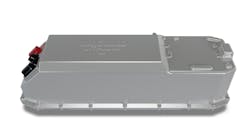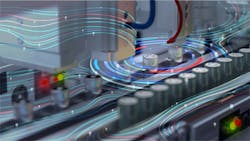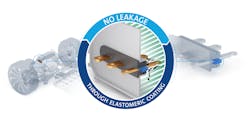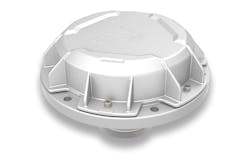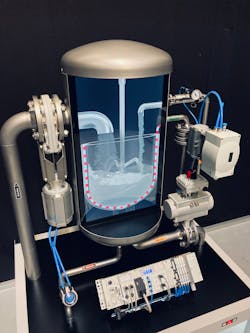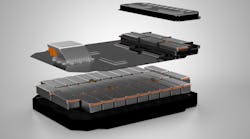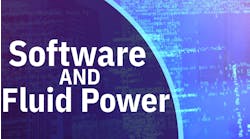This Week in Power & Motion: New Technology Launches for Electric Vehicle Development
There is much going on in the world of hydraulics, pneumatics and electronics motion systems, from technology introductions and industry advancements to new trends and industry leaders. Each week the Power & Motion team collects some of the latest industry news to help keep our readers up to date on what's happening in the fluid power and electronic motion control sectors as well as the industries they serve.
This week we are focusing on news from The Battery Show, an annual event highlighting the latest advancements related to the design and manufacture of electric vehicles. Co-located with the Electric & Hybrid Vehicle Technology Expo, these events spotlight new components such as batteries and electric motors, solutions for testing and producing these products as well as trends in the electrification space.
As development of electric vehicles of various types has grown, so too has this event which is rumored to be moving to Detroit in 2024 because it has outgrown the exhibition space in Novi, MI, where it has been held for the last several years. The continued growth of this show demonstrates how much investment in electrification has increased in recent years, and how it will likely continue to do so in the future.
News and technology launches from the event demonstrates the technological advancements taking place for use in current and future electric vehicle designs.
Bosch Rexroth Automation and Material Transport Technology on Display
At The Battery Show, Bosch Rexroth presented automation, material transport and assembly technology which can be used by battery manufacturers. The company's exhibit included working demonstrations showing how its technology can be tailored to the specific needs of battery manufacturing applications.
Technology highlights at the company's booth included:
- A battery module assembly simulation of a four-station pack assembly process encompassing various Bosch Rexroth technologies to demonstrate how they can work together as a complete system for faster production of batteries.
- End-of-line battery testing, showing how the ctrlX DRIVE can be used to perform battery charge/discharge cycles during testing of batteries once they come to the end of the production line.
- Smart Flex Effector, a sensor-based end effector for robots which can emulate human hands and aid with complex handling applications such as those found in battery manufacturing.
Various mechatronic and transport technologies to aid with various steps of the manufacturing process were displayed as well.
"We are experiencing incredible growth in battery manufacturing driven by the electrification of everything we know. As battery technology advances and demand surges, manufacturers are seeking smart, adaptable manufacturing solutions to help solve complex process challenges while increasing speed to market," said Mark Ziencina, Bosch Rexroth Market Segment Manager for Battery and EV, in the company's press release announcing its presence at the show.
Freudenberg Introduces Seals for Electric Vehicles
Freudenberg Sealing Technologies debuted its newest sealing solution at The Battery Show which is designed specifically for electric vehicle (EV) applications. It is a sealed, rectangular overmold which creates an impermeable seal to protect the power electronics found in EVs.
Creating a tight seal on rectangular busbars has proven to be a challenge in the past. Often they have not provided as tight a seal as desired and required extra work while also taking up additional space in vehicles which is often at a premium. However, the new Freudenberg seal overcomes these challenges. Per the company, it features an elastomeric layer which is applied to the rectangular busbar and bonds firmly with the metallic conductor and the surrounding plastic later in the manufacturing process which helps to ensure a tight seal without taking up additional space in a vehicle or requiring additional post-processing.
"Sealing rectangular shapes is considered the pinnacle in sealing technology, as leakage points often occur in the corners. Thanks to an elastomer layer between the metal and plastic we can now produce sealed busbars – and in a way that saves valuable space, as component and seal virtually become one. This new solution from Freudenberg Sealing Technologies enables our customers to seal their busbars even more reliably, while at the same time offering a high degree of design latitude," said Parisa Burger, Business Development Manager and Project Manager at Freudenberg, in the company's press release announcing the debut of the new sealing solution.
Schaeffler Exhibits Range of Electrification Solutions
At the Electric & Hybrid Vehicle Technology Expo, Schaeffler showcased its wide range of products for use in EVs, including hybrid- and full-electric applications. These include electric axles, thermal management modules with integrated cooling, fuel cell stacks, battery systems and more.
In addition, director of engineering Dr. Rashid Farahati gave a presentation at the event on how solid-state batteries could be the next generation of development focus for EVs. Dr. Farahati discussed the technology itself as well as current challenges in manufacturing this battery type and how those challenges could be overcome.
Battery technology is an area in which many companies are researching new options as there remains a need to not only increase the capabilities of current battery chemistries but also improve their sustainability.
READ MORE: Sodium vs. Lithium: Which is the Better Battery Type?
Briggs & Stratton Adds Motors and Motor Controllers to Electrification Offering
Briggs & Stratton announced at The Battery Show it will expand its line of Vanguard products for EVs to now include motors and motor controllers. This will enable the company to provide OEMs with complete system solutions, something which many are looking for more, especially as they enter the electrification field.
The MVG and MC Series of motors and controllers will be available in different power options to meet the varied voltage needs of multiple equipment types and sizes.
"Integrating a power solution into a piece of equipment requires a scalable approach — especially when it comes to electrified equipment. By adding motors and motor controllers to our portfolio, we’ll be able to better support original equipment manufacturers (OEMs) looking to electrify their equipment with a powerful complete system," said David Frank, Vice President — Electrification at Briggs & Stratton, in the company's press release announcing the launch of the motor technology. "With this new offering, we are in an even better position to serve as a strategic partner to OEMs as we help them navigate the electrification process and meet their battery power goals."
READ MORE: Technology Partnerships Enable Optimized Pairing of Batteries and Fluid Power Systems
Monolith Shows AI's Ability to Aid with Battery Testing
Artificial intelligence (AI) software provider Monolith spoke at The Battery Show about how AI can be used by engineers to speed up development and integration of battery systems. Earlier this year the company introduced an updated version of its machine learning technology Next Test Recommender (NTR) which can aid with these development efforts.
NTR provides engineers with active recommendations on the validation tests to run during the development of hard-to-model, nonlinear products such as batteries and fuel cells. According to Monolith, this technology can help to reduce testing up to 70%.
"In the fast-paced EV market, testing batteries has become a significant bottleneck, hindering the timely launch of EVs. The escalating demand and intense competitive pressure to enhance the range and charging times compound this challenge exponentially," said Dr. Richard Ahlfeld, CEO and founder of Monolith, in an excerpt from his Battery Show speech.
"Engineers perform battery tests across thousands of channels generating terabytes of data per week. They’re running out of test stands and don’t know what optimal tests to run, and certainly don’t have the ability to learn from this vast amount of data as quickly as they need.
"This is where AI comes in. Through the ability to learn from data, test engineers can understand behavior characteristics that are so complex, that without the right tools it is incredibly difficult to decipher. AI software that learns from real world test data is a reliable and effective means for solving the intractable physics of batteries that current simulation and test planning tools don’t efficiently solve."
READ MORE: How to Implement AI in Fluid Power Applications
Festo Showcases Automated Battery Recycling Technology
At The Battery Show, Festo exhibited its technology which can automate the battery recycling process as well as other electric and pneumatic automation technologies. Battery recycling is an important part of ensuring the move to electric vehicles is sustainable and continues to be an area in which many companies are researching.
During the show, the company demonstrated how its controls and process valves could be used to automate the extraction of precious metals from a slurry of shredded EV batteries. Acids in the slurry help to identify the materials to remove, helping ease the process. Festo's CPX-MPA fieldbus-enabled valve terminal controller, the DFPC linear actuator for a knife gate valve, the KVZA pre-assembled process valve, and the VZXA angle seat valve were all part of the exhibit demo.
The company also exhibited how its technology can be used to disassemble battery housings and remove various components which is usually a labor intensive process.
"In order to meet the needs of the rapidly growing EV market, the United States will need to expand battery recycling capabilities, as well as grow our domestic capacity for producing battery precursor materials," said Jigar Shah, Director, Loan Programs Office at the U.S. Department of Energy. "By lowering the cost of the critical materials for lithium-ion batteries using recycled materials, electric vehicles can become more accessible to lower income communities."
Honeywell Exhibits Safety Technology for EVs
Safety is a key concern when it comes to electric vehicles because of the high voltages used and potential for thermal runaway in batteries, among others. Honeywell has developed several solutions to help protect those working with and driving EVs.
Among these technologies are battery safety sensors which can be integrated into battery packs. The sensors can detect thermal runaway and alert drivers so they can take appropriate action. Battery manufacturers who incorporate these sensors into their systems can benefit as well as the technology helps them meet international battery fire safety standards.
Honeywell is working with Nexceris, a developer of Li-ion Tamer lithium-ion gas detection solutions, to develop sensors which can detect thermal runaway faster to help further improve safety.
